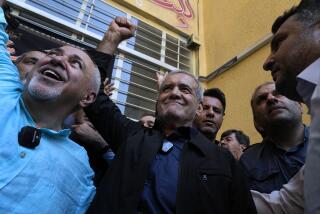Don’t Expect Things to Change Overnight
- Share via
Iran’s parliamentary elections next week are probably the most consequential in the Islamic Republic’s history. It is widely assumed that the results will determine the course of Iran’s foreign policy and, in particular, prospects for a more serious and sustained U.S.-Iran dialogue, if not rapid reconciliation.
Western analysts have cast Iran’s political contest in stark terms of a dualistic battle between forces of light and darkness, respectively represented by so-called reformists and conservatives. But over-simplifying issues and forces in Iran’s politics and basing predictions about its future course on the election outcome has reached unreasonable levels.
There is risk that if there is anything less than a resounding victory for the groups clearly and openly identified with President Mohammad Khatami, any possibility of significant change in Iran in the foreseeable future would be dismissed and efforts to establish a dialogue with the U.S. would be abandoned or at least put into an even lower gear.
To avoid such an outcome, it is essential to understand deeper developments in Iran, beginning with the diversity of views and interests within the so-called reformist and conservative factions.
Neither is homogeneous. Indeed, the conservative coalition has within it elements that were considered reformist from the late 1980s until the mid-1990s, both in economic and social issues and in foreign policy. Meanwhile, the left of the 1980s and ‘90s opposed any moderation of Iran’s confrontational foreign policy, especially toward the United States.
However, since 1989, the left was kept out of government and did not benefit financially from the reconstruction boom of the early 1990s. It thus underwent a change and began supporting both reform and Khatami’s bid for president. In foreign policy, the main goals of these former leftists is to reduce tensions between Iran and other countries.
These shifts underscore that interpreting the outcome of Iran’s elections simply in terms of old stereotypes could lead to false conclusions about the country’s future. Indeed, a reformist agenda can still be carried out even without total victory for the so-called reformist camp, provided that the left abandons its politics of revenge.
Further, in judging Iran’s future directions, emphasis should be put on more basic changes taking place and the adjustments that they will demand from political leaders.
The following are most important:
* Demographic shift and changing priorities. Iran’s population is very young--70% is under 30. This generation’s priority is economic prosperity, or at least significant improvement in its economic prospects and a less-rigid social atmosphere. There is a palpable feeling in Iran of a restless and youthful energy. It must be channeled into constructive endeavors and be allowed to express itself within a less restrictive social setting.
* Erosion of religious values, especially those promoted by the government. Iranian youth no longer can be made to accept deprivation or be motivated by religious indoctrination. Indeed, it is ironic that some pre-revolution, secularized Iranians maintain greater reverence for their religion than those who make a daily show of religiosity. If the abuse of religion in Iranian politics is not reduced--including either abolishing the office of Supreme Leader or limiting its powers over elected officials--the whole Islamic system will come under greater pressure. Already, for a large number of Iranians, reform means secularization.
* Reassertion of Iranianism, in the sense that interests of Iran and its people--most notably maintaining Iran’s territorial integrity--should be the guiding principle of the government’s policies, both domestic and foreign. This also means greater appreciation of Iranian civilization, in both its pre- and post-Islamic versions.
* Creeping multiculturalism and the search for unity in diversity. During the Iran-Iraq war, people from every part of the country took part in the defense of the homeland. Furthermore, education, transportation and communications networks have expanded. Tehran has grown tremendously and become a microcosm of Iran. All these developments have led both to a greater appreciation of the country’s diversity and to the realization of many cultural and historical factors that bind its people together. If these forces are properly channeled, Iran can evolve into the first Islamic country in the Middle East and even beyond where a sense of patriotism and civic nationalism replaces an ethnocentric, repressive and assimilationist nationalism.
However, efforts by outsiders to destabilize Iran--either by encouraging separatist tendencies, as some of its neighbors do, or by putting excessive economic pressure on it--could change this trend toward cultural and political pluralism and resurrect a more homogenizing and constraining nationalism.
In sum, while next week’s elections are important, Iran’s future should not be judged on the basis of the outcome. A conservative victory could not arrest the fundamental changes that are taking place within Iran. Nor would a reformist victory change everything overnight.
Iran is already beyond its Islamic stage of evolution. The educational and economic reforms of the shah’s era led to a religious reaction. The Islamic Revolution has done its work of raising the political consciousness of the masses by its tactics of indoctrination. In doing so, it has given rise to its own antithesis. The next stage is Iran’s embrace of modernity and the recasting of its Iranian and Islamic traditions in the modernist context.
How soon and how easily that will happen is the real question to be answered.
More to Read
Sign up for Essential California
The most important California stories and recommendations in your inbox every morning.
You may occasionally receive promotional content from the Los Angeles Times.













